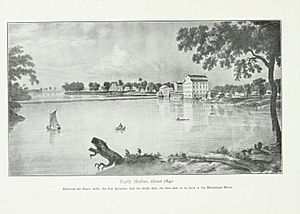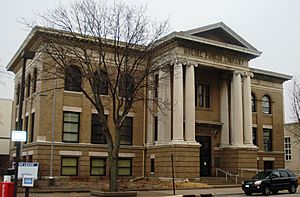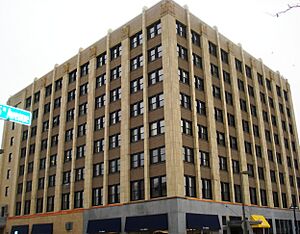Moline Downtown Commercial Historic District facts for kids
Quick facts for kids |
|
|
Moline Downtown Commercial Historic District
|
|

Downtown Moline from the west with First Lutheran Church on the right.
|
|
| Location | Roughly bounded by 12th St. to 18th St., 4th Ave. to 7th Ave., Moline, Illinois |
|---|---|
| Area | 33-acre (0.13 km2) |
| Architectural style | Late 19th and early 20th Century Revivals |
| NRHP reference No. | 07000856 |
| Added to NRHP | August 30, 2007 |
The Moline Downtown Commercial Historic District is a special area in Moline, Illinois, United States. It's recognized as an important historic district because of its old and unique buildings. This district is mainly around 5th Avenue. It stretches from 12th Street to 18th Street, and from 4th Avenue to 7th Avenue. The area covers about 33 acres and has 114 buildings. One hundred of these buildings are very important. They still look like they did long ago and show the history of downtown Moline.
Contents
The Story of Moline's Downtown
The city of Moline began when David B. Sears arrived in 1836. He built a brush and stone mill in 1838. This area was first called Rock Island Mills. Other mills soon opened here. They ground corn and wheat, and turned logs into lumber.
John Deere started his first factory in 1847. It was along the Mississippi River. His company later became Deere & Company. The area was renamed Moline, which means "milltown" in French. Moline officially became a town on April 21, 1848.
How Downtown Moline Grew
Moline's first downtown area was on Third Avenue. It was near the factories and mills by the river. Most buildings were two or three stories tall. They were made of brick in the Italianate style.
Railroad tracks separated this early downtown from the rest of the city. The first train came through in 1854. By 1895, 75 trains passed through daily. This made it hard for people to reach the main business area.
Around the year 1900, businesses started moving south of the tracks. They first chose 15th Street. This street had a trolley line that went up the hill to newer neighborhoods. In the 1910s, many large buildings were built on Fifth Avenue. This street then became the main downtown area. Sixth Avenue also became a busy street. Some beautiful old homes were lost as new businesses moved in.
Downtown in the 1920s
By the 1920s, downtown Moline was thriving. Bank buildings had offices on upper floors. Other office buildings offered many professional services. Two buildings, the Fifth Avenue Building and the one now called Chase Bank, were eight stories tall.
The LeClaire Hotel opened in 1922. It was a major building on the east side of downtown. On the west side, the large First Lutheran Church was built in 1876. Downtown also had department stores, small shops, theaters, hotels, restaurants, and bars. Important public buildings were also built. These included the Carnegie Library (1904), City Hall (1914), Elks Club (1924), and the Unitarian Church (1928).
Changes Over Time
Downtown Moline stayed the main business and cultural center until the mid-1900s. It was also where parades and other city events took place. In the 1940s, car dealerships and gas stations appeared on the edges of downtown.
Five big department stores were located downtown. These included Block & Kuhl Company, New York Store, J. C. Penney, Sears, Roebuck & Company, and Montgomery Ward & Company. In the 1950s and 1960s, many storefronts were updated to look more modern.
The department stores closed in the 1970s and 1980s. This happened after SouthPark Mall opened in 1974. Since then, some old buildings have been torn down. But most buildings still look like they did historically. New buildings have also been built along the river. This happened after the TaxSlayer Center opened in 1993.
Cool Building Styles
The Moline Downtown Commercial Historic District has many different building styles. You can see Beaux-Arts, Colonial Revival, Neoclassical, Gothic Revival, Tudor Revival, Italian Renaissance, Prairie School, Moderne, Art Deco, Chateauesque, and Commercial styles.
Several famous local architects designed some of the most important buildings. Olaf Z. Cervin designed the First National Bank Building, which is now Chase Bank. He also designed the Reliance Block. H. W. Wittsett designed the Moline Commercial Club.
William Schultzke designed the most historic buildings downtown. He created the Bell Telephone Building, Montgomery Ward, Moline National Bank (now First Midwest Bank), the Fifth Avenue Building, Sohrbecks, Carlson Brothers, Elks Club, and City Hall.






